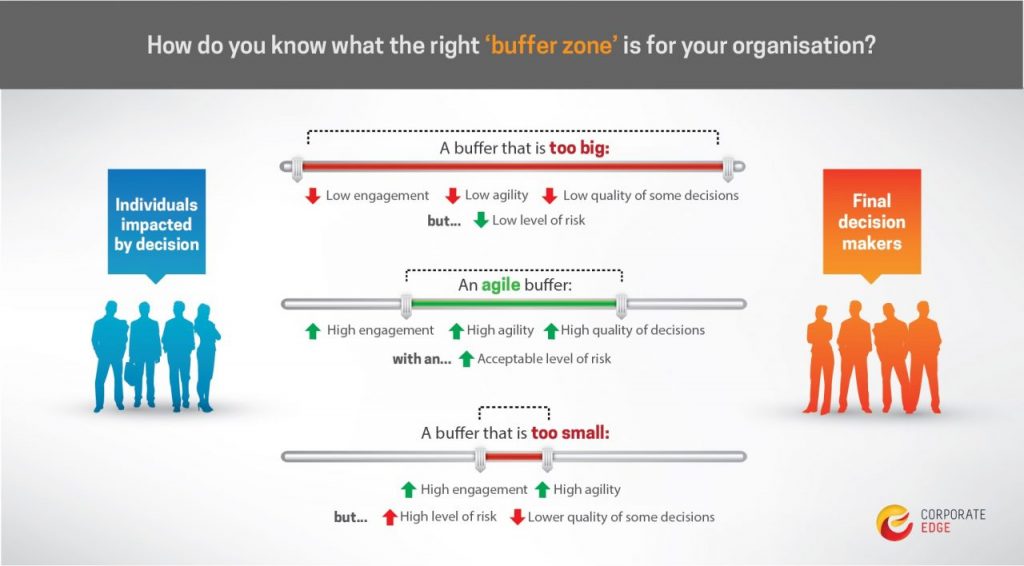As we begin to resurface from the socio-economic crisis that was COVID-19 into a new form of normality, the prevailing ability successful businesses have displayed which has allowed them to craft quick effective solutions is agility.
Organisations famous for being agile, who are adaptive, flexible and creative in a crisis, are known for having high levels of empowerment, meaning they have a small ‘buffer’ for people who are empowered to make decisions in real time. Embodying this capability has proven to enable businesses to respond quickly to opportunities or threats, whether internal or external.
The recent and still existing outbreak that continues to pose numerous challenges to businesses, has forced leaders to be more agile and nimble at very short notice, resulting in reduction of the ‘buffer zone’ between decision and action.
So how do you know if you have the right ‘buffer zone’ in place to allow you to succeed like other agile organisations? Continue reading below to find out.
The ‘Buffer Zone’
So, what do we mean when we say ‘buffer’? Quite simply, the buffer zone is the distance between a person who’s making a final decision and the point in time where the impact and natural consequences of that decision is going to be felt. It is the number of layers that exist between where an issue or opportunity is needing to be dealt with through a decision, and the person who is making that final decision.

What happens if we have no buffer? This is effectively a reckless act. Why? Picture this. If you’re a parent with a young child, you wouldn’t leave them alone in a bathtub for obvious reasons. As well, you wouldn’t leave them in the presence of sharp knives or utensils, again for obvious reasons. You would be consistently supervising them and observing their actions to ensure their safety and emotional development.
These scenarios can translate to businesses having buffer zones in place. Having acceptable buffers in place minimises risk and/or ensures that you are creating an acceptable level of risk. These risks include safety, ensuring you have the correct checks in place to protect your team; compliance, making sure you are upholding the legal and ethical standards based on your responsibilities as an organisation; as well as your brand, protecting the reputation of your organisation and guaranteeing you’re not making decisions that could create reputational damage.
To minimise all these risks in the event of a crisis, or a case where quick action is required, an appropriate buffer needs to be put in place to safeguard all areas.
How to Create the Right Buffer
To sustain agility whilst maintaining an acceptable level of risk mitigation, leaders must ensure they are empowering their team who are close to a potential issue or opportunity and get them to feel equipped to make effective decisions in real time. To do this, you must find the right balance between RISK and EMPOWERMENT.
By increasing your buffer, you decrease your risk but also decrease the engagement of your team. In addition, you are also decreasing your agility and the quality of your decisions.
On the other hand…
If you decrease your buffer, you are potentially increasing your risk, but also increasing your team engagement, agility and quality of the decision making that takes place.
How to Find the ‘Happy Medium’
To find the right balance, there are a few things to consider.
- Firstly, the team involved. There must be a great level of trust, how much you trust your team to do the right thing, to have the best intentions and make the right decisions. This also includes their capability to be able to make decisions that suit the circumstances that they’re facing at that point in time.
- Secondly is the weight of the risk and potential consequences that could occur. What could be at stake if the wrong decision is made and the likelihood of the mistake happening? What will be the consequence of the delay in acting?
When you weigh up trust and capability of your team with the consequences of error and delay, it allows you find the happy medium for the right buffer for your organisation, reducing risk but increasing engagement, agility and quality decisions.
On a final note, as a leader you should ask yourself whether you feel you have the current buffer for empowerment: is it hindering your business, or is it protecting you whilst allowing you and your team to succeed.
To learn more about the buffer zone and the rewards from establishing a healthy medium watch the video below from Director John Colbert.



